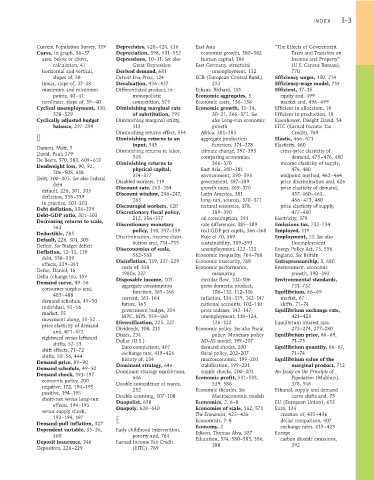Page 913 - Krugmans Economics for AP Text Book_Neat
P. 913
INDEX I-3
Current Population Survey, 119 Depreciates, 420–424, 436 East Asia “The Effects of Government
Curve, in graph, 36–37 Depreciation, 398, 531–532 economic growth, 380–382 Taxes and Transfers on
area, below or above, Depressions, 10–11. See also human capital, 386 Income and Property”
calculation, 41 Great Depression East Germany, structural (U.S. Census Bureau),
horizontal and vertical, Derived demand, 681 unemployment, 132 770
slopes of, 38 Detroit Free Press, 124 ECB (European Central Bank), Efficiency wages, 130, 714
linear, slope of, 37–38 Devaluation, 436–437 253 Efficiency-wage model, 714
maximum and minimum Differentiated product, in Eckaus, Richard, 101 Efficient, 17–18
points, 40–41 monopolistic Economic aggregates, 5 equity and, 499
nonlinear, slope of, 39–40 competition, 575 Economic costs, 136–138 market and, 496–499
Cyclical unemployment, 130, Diminishing marginal rate Economic growth, 13–14, Efficient in allocation, 18
328–329 of substitution, 795 20–21, 366–371. See Efficient in production, 18
Cyclically adjusted budget Diminishing marginal utility, also Long-run economic Eisenhower, Dwight David, 54
balance, 297–299 513 growth EITC (Earned Income Tax
Credit), 769
D Diminishing returns effect, 554 Africa, 381–383 Elastic, 466–471
aggregate production
Diminishing returns to an
input, 545 function, 374–378 Elasticity, 460
Damon, Matt, 5 Diminishing returns to labor, climate change, 392–393 cross-price elasticity of
David, Paul, 379 545 comparing economies, demand, 475–476, 480
De Beers, 570, 583, 609–613 Diminishing returns to 366–370 income elasticity of supply,
Deadweight loss, 90, 92, physical capital, East Asia, 380–381 476, 480
506–508, 618
374–377
Debt, 300–305. See also Federal Disabled workers, 119 environment, 390–393 midpoint method, 462–464
government, 387–389
price discrimination and, 626
debt
default, 226, 301, 305 Discount rate, 263–264 growth rates, 369–370 price elasticity of demand,
457, 460–463,
Latin America, 381
Discount window, 246–247,
deflation, 338–339 263 long-run, sources, 370–371 466–473, 480
in practice, 301–303
Debt deflation, 338–339 Discouraged workers, 120 natural resources, 378, price elasticity of supply,
477–480
Discretionary fiscal policy,
389–390
Debt-GDP ratio, 301–303 212, 356–357 oil consumption, 391 Electricity, 379
Decreasing returns to scale, Discretionary monetary rate differences, 385–389 Emissions tax, 732–734
563
policy, 348, 357–359
Deductible, 785 Discrimination, income distri- real GDP per capita, 366–368 Employed, 119
Employment, 12. See also
Rule of 70, 369
Default, 226, 301, 305 bution and, 714–715 sustainability, 389–393 Unemployment
Deficit. See Budget deficit Diseconomies of scale, unemployment, 122–123 Energy Policy Act, 75, 596
Deflation, 12–13, 139 562–563 Economic inequality, 764–768 England. See Britain
debt, 338–339 Disinflation, 139, 327–329 Economic insecurity, 768 Entrepreneurship, 3, 680
effects, 339–341
Defoe, Daniel, 16 costs of, 338 Economic performance, Environment, economic
growth, 390–393
1980s, 337
measuring
Delta (change in), 159 Disposable income, 105 circular flow, 102–106 Environmental standards,
Demand curve, 49–56 aggregate consumption gross domestic product, 731–732
consumer surplus and, function, 165–166 106–110, 112–116 Equilibrium, 66–69
483–488
demand schedule, 49–50 current, 161–164 inflation, 134–139, 142–147 market, 67
future, 165
shifts, 71–74
national accounts, 102–110
individual, 55–56 government budget, 204 price indexes, 142–147 Equilibrium exchange rate,
market, 55 MPC, MPS, 159–160 unemployment, 118–124, 421–423
movement along, 51–52 Diversification, 225, 227 126–132 Equilibrium interest rate,
price elasticity of demand Dividends, 108, 211 Economic policy. See also Fiscal 273–274, 277–280
and, 471–472
policy; Monetary policy
rightward versus leftward Dixies, 234 AD-AS model, 199–207 Equilibrium price, 66–69,
Dollar (U.S.)
71–75
shifts, 52–53
shift effects, 71–72 Euro comparison, 407 demand shocks, 200 Equilibrium quantity, 66–67,
fiscal policy, 202–207
exchange rate, 419–426
71–74
shifts, 50–56, 444
history of, 234
Demand price, 89–90 Dominant strategy, 646 macroeconomic, 199–201 Equilibrium value of the
marginal product, 712
stabilization, 199–201
Demand schedule, 49–50 Dominant strategy equilibrium, supply shocks, 200–201 An Essay on the Principle of
Demand shock, 191–197 646 Economic profit, 531–533, Population (Malthus),
economic policy, 200 Double coincidence of wants, 539, 586 378, 546
negative, 172, 194–195 232 Economic theories. See Ethanol, supply and demand
positive, 194–195 Double-counting, 107–108 Macroeconomic models curve shifts and, 75
short-run versus long-run Duopolist, 638 Economics, 2, 6–8 EU (European Union), 653
effects, 194–195
versus supply shock, Duopoly, 638–640 Economies of scale, 562, 571 Euro, 134
creation of, 435–436
The Economist, 425–426
193–194, 197 E
Demand-pull inflation, 327 Economists, 7–8 dollar comparison, 407
exchange rates, 419–423
Economy, 2
Dependent variable, 35–36, Early childhood intervention, Edison, Thomas Alva, 387 Europe
460 poverty and, 764
Deposit insurance, 246 Earned Income Tax Credit Education, 374, 380–383, 386, carbon dioxide emissions,
392
388
Depositors, 228–229 (EITC), 769

